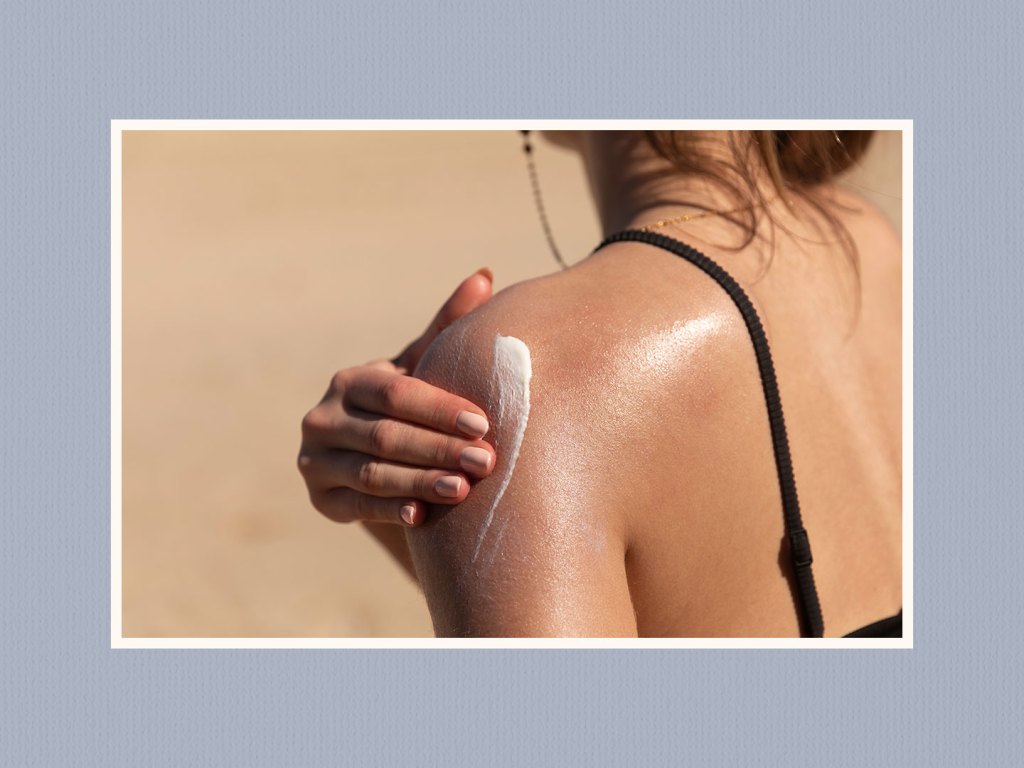Gen Z is notoriously invested in their skincare. We’re speaking a few era of younger folks raised on 10-step TikTok skincare routines, filling their holiday wish lists with lip masks and Drunk Elephant merchandise, slathering on anti-aging merchandise on the ripe age of 16. And certain, we tease them about it as millennials and Gen Xers, however you additionally should admire the dedication to wholesome pores and skin.
After which this summer time’s newest magnificence pattern began making its approach throughout TikTok. It seems, tan is in once more (was it ever out?) and Gen Z is taking it to a brand new degree. Their technique? Observe the UV index and exit when when it’s at its peak. Efficient — sure. Probably dangerous — sadly, additionally sure.
What’s the TikTok UV index tanning pattern?
Throughout TikTok, “teenagers and younger ladies advocate following the UV index and going outdoors to tan when the UV is within the larger ranges,” Dr. Kseniya Kobets, MD, Director of Beauty Dermatology at Montefiore-Einstein Superior Care, tells SheKnows.
A fast skim of TikTok reveals movies of younger ladies sharing their secrets and techniques to getting the right bikini tanline, debating the correct index to tan at, and even complaining once they skipped tanning on what was forecast to be a low UV day (4) solely to see the solar come out vibrant and the UV are available in at an 8. “It was such a missed alternative!” that TikToker laments.
So what’s the UV index?
The UV index is a scale that measures “the depth and potential harm of ultraviolet (UV) rays on a given day,” Dr. Kobets explains. The index runs from 0 to 11+; the upper the quantity, the larger threat of pores and skin harm. Something 8 and above is outlined as “Further safety wanted,” based on the Environmental Safety Company. “Watch out outdoors, particularly throughout late morning by way of mid-afternoon,” the EPA cautions, noting that when you’re outdoors, you need to be in protecting clothes, minimal SPF-15 sunscreen, and a wide-brimmed hat.
In fact, this tanning pattern has teenagers, tweens, and younger adults doing simply the other. “I don’t even take the time to go outdoors when it’s 5 or decrease,” one younger girl said on TikTok. “One of the best UV index to go outdoors is clearly 11.”
Is the UV index tanning pattern dangerous?
“It’s effectively established that intense UV publicity, particularly sufficient to trigger sunburn, will increase the chance of skin cancer,” says Dr. Kobets. UV radiation, she explains, “damages pores and skin cells at a molecular degree, even when there is no such thing as a seen sunburn.” That implies that “repeated or intense publicity” to excessive UV ranges “could cause cumulative DNA harm, which will increase most cancers threat and results in untimely ageing.”
For reference, Dr. Kobets notes, getting only one unhealthy sunburn with blisters earlier than you’re 18 can improve your lifetime threat of melanoma by about 50 p.c. And even with out seen redness and burns, “UV rays from each the solar and tanning beds trigger DNA harm in pores and skin cells,” she explains. “This not solely raises the chance of pores and skin most cancers but additionally accelerates indicators of ageing like wrinkles, pores and skin sagging, hyperpigmentation, and sunspots.”
Altogether, Dr. Kobets calls the UV index tanning pattern “extraordinarily regarding.” In search of out excessive UV publicity for the sake of getting tan “ignores long-term dangers in favor of short-term look adjustments,” she explains. It’s a pattern she’s seen not simply on the web however in her personal observe as effectively. “Younger sufferers are sometimes drawn to the moment gratification of a tan and will not totally admire the long-term penalties,” she notes. “Gen Z could be very invested in skincare and wellness, but additionally susceptible to viral tendencies that will lack scientific backing.”
A part of the issue? Regardless of what we all know concerning the harms of tanning, Western tradition nonetheless associates a bronzed glow with “healthy-looking pores and skin.” Each new era must be educated concerning the long-term harms of high-UV solar publicity. Even Gen Z, who’re extra in-the-know about skincare than any of us, might use a reminder.
What can dad and mom do?
To that finish, your teenagers and tweens may want a summer time skincare refresher. Per Dr. Kobets, which means going again to the fundamentals of solar safety:
Staying within the shade when you may, particularly between 10 am and 4 pm.
Utilizing broad-spectrum SPF 30-50 and reapplying at the least each two hours (extra often if you’re swimming or sweating).
Sporting UPF-protective clothes so the solar doesn’t penetrate your garments. Huge-brimmed hats and sun shades are additionally a good suggestion.
Choosing mineral-based sunscreens for delicate, eczema-prone, or easily-irritated pores and skin. This consists of sunscreens with energetic elements of zinc oxide or titanium dioxide.
Utilizing self-tanners as a substitute. Dr. Kobets recommends utilizing a self-tanner with DHA or botanical based mostly, DHA-free self-tanners, each of that are “safer different[s] to UV tanning.”
As for relay these tricks to your tanning-obsessed teenagers, effectively, it begins with “sincere, age-appropriate conversations,” Dr. Kobets says. “Emphasize that pores and skin most cancers is not only a distant threat, it may imply scars from surgical excisions, continual pores and skin adjustments, and even lack of life in circumstances like melanoma.” She additionally recommends highlighting how costly it may get to reverse solar harm with beauty therapies.
In fact, you’ll additionally wish to hearken to your individual recommendation. “Mannequin sun-safe habits your self,” Dr. Kobets says. “Teenagers usually tend to hear once they see you making use of sunscreen and caring for your individual pores and skin.”
Earlier than you go, store our favourite skincare manufacturers for teenagers:

